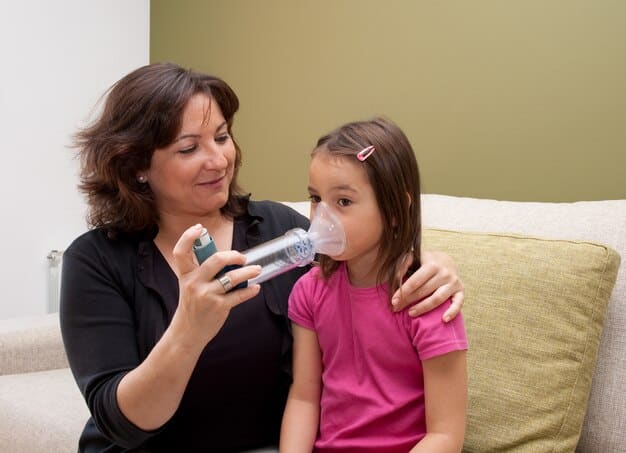Latest Childhood Asthma Treatments: A Guide for US Families

The Latest Advancements in Treating Childhood Asthma include personalized treatment plans, innovative inhaler devices, and biologic therapies that target the underlying causes of asthma, aiming to improve symptom control and quality of life for children and their families in the US.
The Latest Advancements in Treating Childhood Asthma: What US Families Should Know are revolutionizing how this common childhood condition is managed. With asthma affecting millions of children in the United States, staying informed about the newest treatments is crucial for ensuring optimal health outcomes and a better quality of life for affected kids.
Understanding Childhood Asthma: A Brief Overview
Childhood asthma is a chronic respiratory disease that inflames and narrows the airways, making it difficult to breathe. It’s a common condition among children in the United States, and while there’s no cure, it can be effectively managed with the right treatment and care.
Understanding the basics of asthma, including its triggers and symptoms, is the first step in providing the best possible care for children affected by this condition.
Common Asthma Triggers in Children
Asthma triggers vary from child to child, but some of the most common include allergens, irritants, and respiratory infections. Identifying and avoiding these triggers is essential for managing asthma symptoms.
- Allergens: Pollen, dust mites, pet dander, and mold can all trigger asthma symptoms.
- Irritants: Smoke, air pollution, and strong odors can irritate the airways.
- Respiratory Infections: Colds, flu, and other respiratory infections can exacerbate asthma.
- Exercise: Physical activity can sometimes trigger asthma, known as exercise-induced asthma.
Recognizing Asthma Symptoms
Recognizing the symptoms of asthma is crucial for early diagnosis and treatment. Common symptoms include wheezing, coughing, shortness of breath, and chest tightness.

It’s important to note that asthma symptoms can vary in severity and frequency, and they may worsen at night or during exercise.
In summary, understanding the triggers and symptoms of childhood asthma is essential for effective management. By identifying and avoiding triggers and recognizing symptoms early, parents and caregivers can help children with asthma lead healthy, active lives.
Personalized Asthma Treatment Plans
One of the most significant advancements in treating childhood asthma is the shift toward personalized treatment plans. These plans are tailored to each child’s specific needs, considering factors such as age, asthma severity, triggers, and response to medication.
Personalized asthma treatment plans are developed in collaboration with healthcare providers and involve regular monitoring and adjustments to ensure optimal symptom control.
Components of a Personalized Asthma Treatment Plan
A personalized asthma treatment plan typically includes medication, trigger management strategies, and education about asthma self-management.
- Medication: Controller medications to reduce airway inflammation and rescue medications for quick relief of symptoms.
- Trigger Management: Strategies to avoid or minimize exposure to asthma triggers.
- Education: Information about asthma, medication use, and self-management techniques.
Regular check-ups with a healthcare provider are essential for monitoring asthma control and making necessary adjustments to the treatment plan.
By tailoring treatment to each child’s individual needs, personalized asthma treatment plans can significantly improve asthma control and quality of life.
New and Improved Inhaler Devices
Advancements in inhaler technology have made it easier and more effective for children to take their asthma medication. Newer devices are designed to be more user-friendly, delivering medication more efficiently to the airways.
These advancements include features such as improved dose counters, easier-to-use designs, and the integration of technology to track medication use.
Types of Advanced Inhaler Devices
Several types of advanced inhaler devices are now available, each with its own advantages and features.
- Smart Inhalers: These devices track medication use and provide reminders to take medication.
- Soft Mist Inhalers: These inhalers deliver a slow-moving mist that is easier to inhale.
- Dry Powder Inhalers: These devices deliver medication in a powder form, eliminating the need for coordination between actuation and inhalation.
Choosing the right inhaler device depends on factors such as the child’s age, coordination skills, and preference. Healthcare providers can help families select the most appropriate device.
In summary, new and improved inhaler devices are making it easier for children to manage their asthma effectively. With features such as improved dose counters and easier-to-use designs, these devices can help children take their medication correctly and consistently.
Biologic Therapies for Severe Asthma
For children with severe asthma that is not well-controlled with standard treatments, biologic therapies offer a promising new option. These medications target specific molecules in the body that contribute to airway inflammation and asthma symptoms.
Biologic therapies are typically administered by injection or infusion and are reserved for children with severe asthma who meet specific criteria.
How Biologic Therapies Work
Biologic therapies work by blocking the action of specific molecules involved in the inflammatory process in the airways. This can reduce airway inflammation, improve lung function, and decrease asthma symptoms.

Examples of biologic therapies used to treat asthma include anti-IgE, anti-IL-5, and anti-IL-4 receptor antibodies.
While biologic therapies are not a cure for asthma, they can significantly improve asthma control and reduce the need for oral corticosteroids in children with severe asthma.
Biologic therapies provide a targeted approach to treating severe asthma, offering hope for children who do not respond well to traditional treatments. By blocking specific molecules involved in airway inflammation, these therapies can improve symptom control and quality of life.
The Role of Technology in Asthma Management
Technology is playing an increasingly important role in asthma management, with apps, wearable devices, and telehealth services offering new ways to monitor and manage asthma symptoms.
These tools can help children and their families track asthma triggers, monitor lung function, and communicate with healthcare providers remotely.
Examples of Technology-Based Asthma Management Tools
Several technology-based tools are available to help children and their families manage asthma.
- Asthma Apps: These apps allow users to track symptoms, medications, and triggers, and some provide personalized recommendations for managing asthma.
- Wearable Devices: These devices monitor lung function and provide alerts when asthma symptoms are worsening.
- Telehealth Services: These services allow children and their families to communicate with healthcare providers remotely, reducing the need for in-person visits.
By using technology to monitor and manage asthma, children and their families can take a more proactive approach to asthma care.
In conclusion, technology is transforming asthma management, with apps, wearable devices, and telehealth services offering new ways to monitor and improve asthma control. By using these tools, children and their families can take a more active role in managing their asthma and improving their overall health.
Lifestyle Adjustments and Home Remedies
In addition to medical treatments, lifestyle adjustments and home remedies can play a significant role in managing childhood asthma. Creating a healthy home environment, practicing relaxation techniques, and maintaining a healthy diet can all help reduce asthma symptoms.
These strategies are not a substitute for medical treatment but can complement it and improve overall asthma control.
Effective Lifestyle Adjustments and Home Remedies
Several lifestyle adjustments and home remedies can help manage childhood asthma.
- Creating a Healthy Home Environment: Reducing exposure to allergens and irritants, such as dust mites, pet dander, and smoke.
- Practicing Relaxation Techniques: Using techniques such as deep breathing and meditation to reduce stress and anxiety, which can trigger asthma symptoms.
- Maintaining a Healthy Diet: Eating a balanced diet rich in fruits, vegetables, and whole grains to support overall health and reduce inflammation.
Working with a healthcare provider to develop a comprehensive asthma management plan that includes both medical treatments and lifestyle adjustments is essential.
Making lifestyle adjustments and using home remedies can complement medical treatments and improve asthma control. By creating a healthy home environment, practicing relaxation techniques, and maintaining a healthy diet, children with asthma can reduce their symptoms and improve their overall health.
| Key Point | Brief Description |
|---|---|
| ⚕️ Personalized Plans | Treatment tailored to individual needs, improving control. |
| 💨 Advanced Inhalers | User-friendly devices for efficient medication delivery. |
| 🔬 Biologic Therapies | Targeted treatments for severe, uncontrolled asthma. |
| 📱 Tech Integration | Apps and wearables for monitoring and managing asthma. |
Frequently Asked Questions
▼
Early signs include frequent coughing, wheezing, shortness of breath, and difficulty breathing. Symptoms may worsen at night or during physical activity, indicating possible asthma.
▼
Keep a detailed symptom diary, noting activities, locations, and exposures before each episode. Common triggers include allergens, smoke, and infections. Consult a doctor for allergy testing.
▼
Medications include quick-relief (rescue) inhalers for immediate symptom relief and long-term control inhalers to reduce airway inflammation. Biologic therapies are for severe cases.
▼
Use allergen-proof bedding, regularly clean to reduce dust mites and mold, avoid smoking indoors, and use air purifiers to remove airborne particles and irritants.
▼
Seek immediate care if your child has severe difficulty breathing, cannot speak in full sentences, has blue lips or fingernails, or if rescue medication does not provide relief.
Conclusion
Staying informed about the latest advancements in treating childhood asthma is crucial for US families. Personalized treatment plans, advanced inhaler devices, biologic therapies, and technology-based tools are transforming asthma management, offering hope for improved symptom control and quality of life. By working closely with healthcare providers and adopting proactive strategies, parents and caregivers can help children with asthma lead healthy and active lives.





